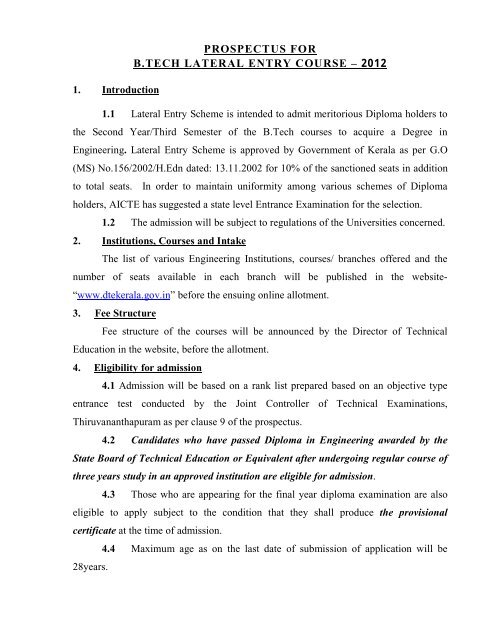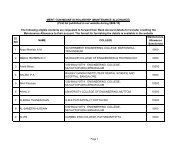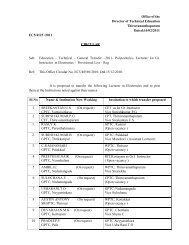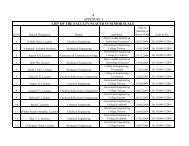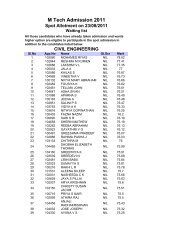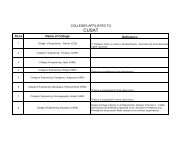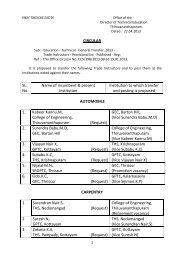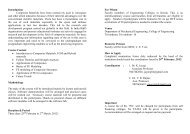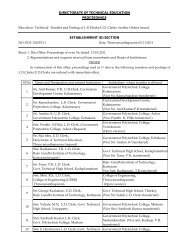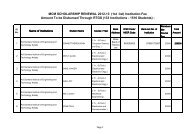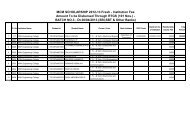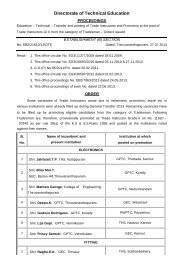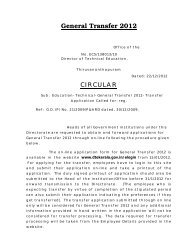prospectus for b.tech lateral entry course - Directorate of Technical ...
prospectus for b.tech lateral entry course - Directorate of Technical ...
prospectus for b.tech lateral entry course - Directorate of Technical ...
Create successful ePaper yourself
Turn your PDF publications into a flip-book with our unique Google optimized e-Paper software.
1. IntroductionPROSPECTUS FORB.TECH LATERAL ENTRY COURSE – 20121.1 Lateral Entry Scheme is intended to admit meritorious Diploma holders tothe Second Year/Third Semester <strong>of</strong> the B.Tech <strong>course</strong>s to acquire a Degree inEngineering. Lateral Entry Scheme is approved by Government <strong>of</strong> Kerala as per G.O(MS) No.156/2002/H.Edn dated: 13.11.2002 <strong>for</strong> 10% <strong>of</strong> the sanctioned seats in additionto total seats. In order to maintain uni<strong>for</strong>mity among various schemes <strong>of</strong> Diplomaholders, AICTE has suggested a state level Entrance Examination <strong>for</strong> the selection.1.2 The admission will be subject to regulations <strong>of</strong> the Universities concerned.2. Institutions, Courses and IntakeThe list <strong>of</strong> various Engineering Institutions, <strong>course</strong>s/ branches <strong>of</strong>fered and thenumber <strong>of</strong> seats available in each branch will be published in the website-“www.dtekerala.gov.in” be<strong>for</strong>e the ensuing online allotment.3. Fee StructureFee structure <strong>of</strong> the <strong>course</strong>s will be announced by the Director <strong>of</strong> <strong>Technical</strong>Education in the website, be<strong>for</strong>e the allotment.4. Eligibility <strong>for</strong> admission4.1 Admission will be based on a rank list prepared based on an objective typeentrance test conducted by the Joint Controller <strong>of</strong> <strong>Technical</strong> Examinations,Thiruvananthapuram as per clause 9 <strong>of</strong> the <strong>prospectus</strong>.4.2 Candidates who have passed Diploma in Engineering awarded by theState Board <strong>of</strong> <strong>Technical</strong> Education or Equivalent after undergoing regular <strong>course</strong> <strong>of</strong>three years study in an approved institution are eligible <strong>for</strong> admission.4.3 Those who are appearing <strong>for</strong> the final year diploma examination are alsoeligible to apply subject to the condition that they shall produce the provisionalcertificate at the time <strong>of</strong> admission.28years.4.4 Maximum age as on the last date <strong>of</strong> submission <strong>of</strong> application will be
4.5 Non-Keralities are also eligible to apply but their admission will berestricted to the Private Self financing institutions & non-Government seats in theGovernment controlled Self-financing institutions.4.6 Candidates will be admitted only to the branch <strong>of</strong> Engineering as per theequivalency given in Annexure A.5. Reservation <strong>of</strong> seats5.1 All seats under Lateral Entry scheme in Government Engineering Collegeswill be allotted as Government seats.5.2 The availability <strong>of</strong> Government seats in Government controlled and otherPrivate Self-Financing Engineering Colleges will be announced be<strong>for</strong>e ensuing onlineadmission.5.3 15% <strong>of</strong> seats under Lateral Entry are reserved as Management seats inAided Engineering Colleges and remaining 85% will be allotted as Government seats.5.4 Communal reservation <strong>for</strong> candidate belonging to Socially andEducationally Backward Classes(SEBC) and SC/ST category will be followed as perusual norms(Ezhava-9%,Muslim-8%,Latin Catholic other than Anglo Indian-2%,B.H-5%,Backward Christian-1%,Kudumbi-1%,Scheduled Caste-8% and Scheduled Tribe-2%).5.5 3% seats are reserved <strong>for</strong> physically disabled candidates. Candidatesclaiming reservation under physically disabled quota shall have a minimum <strong>of</strong> 40%disability. A disability Certificate from the District Medical Board has to be attachedalong with the application. Such candidates are also directed to produce a certificateobtained from a Medical <strong>of</strong>ficer not below the rank <strong>of</strong> Assistant surgeon to ensure thefitness <strong>of</strong> candidates to undergo the <strong>course</strong>.5.6 One seat each is reserved <strong>for</strong> Electronics and Communication Engineering,Electrical & Electronics Engineering, Civil Engineering, Mechanical Engineering,Computer Science Engineering and In<strong>for</strong>mation Technology branch <strong>for</strong> defence quota.For claiming reservation in this quota, relevant certificate should be attached.5.7 80% <strong>of</strong> the available seats in In<strong>for</strong>mation Technology branch are reserved<strong>for</strong> the Diploma Holders in In<strong>for</strong>mation Technology.2
6. Claim <strong>for</strong> Communal Reservation6.1 Candidates belonging to SEBC whose annual family income (annualincome <strong>of</strong> all members in the family from all sources taken together) is up to Rs.4.5lakhs are eligible <strong>for</strong> reservation under this category.6.2 Candidates claiming reservation under SEBC category should produceboth community and income certificates obtained from the concerned village <strong>of</strong>ficer inthe space provided in the body <strong>of</strong> the application <strong>for</strong>m.6.3 The candidates claiming reservation under SC/ST quota should producecommunity certificate in the space provided in the body <strong>of</strong> the application <strong>for</strong>m.6.4 In the absence <strong>of</strong> SC/ST candidates, their seats will be filled from OECcategory and they have to furnish community and income certificates from the VillageOfficer in the space provided in the body <strong>of</strong> the application <strong>for</strong>m.6.5 Candidates who are not eligible <strong>for</strong> communal reservation benefit and whowish to be considered <strong>for</strong> any scholarship/concession based on the family income thatmay be announced by Government/College/Admitting Authority at any time after thesubmission <strong>of</strong> application should also submit the income certificate, from the concernedauthorities at the time <strong>of</strong> submission <strong>of</strong> application itself.7. Application FormsApplication <strong>for</strong>ms and <strong>prospectus</strong> are available in the websites -“www.dtekerala.gov.in”, “www.tekerala.org” Application fee is Rs.750/- <strong>for</strong> generalcandidates and Rs.375/- - <strong>for</strong> SC/ST candidates, which can be paid in ‘ShaktiAccount’ <strong>of</strong> the Joint Controller <strong>of</strong> <strong>Technical</strong> Examination from any branch <strong>of</strong>State Bank <strong>of</strong> Travancore. ST candidates whose annual income is below Rs.40, 000/-are exempted from paying application fee on condition that they produce incomecertificate <strong>for</strong> the same.8. Submission <strong>of</strong> ApplicationApplications are to be submitted online and the downloaded application<strong>for</strong>m duly filled up along with the relevant certificates and Shakti chalan <strong>for</strong>mshould reach The Joint Controller <strong>of</strong> <strong>Technical</strong> Examinations, Kaimanam,3
Thiruvananthapuram- 695040 by Registered Post/ or in person. The last date <strong>for</strong> thereceipt <strong>of</strong> application is as per the schedule given in Annexure B.9. Entrance Examination9.1 A state level OMR based objective type Entrance Test <strong>for</strong> duration <strong>of</strong> 2hours will be conducted by The Joint Controller <strong>of</strong> <strong>Technical</strong> Examinations,Kaimanam, Thiruvananthapuram <strong>for</strong> the selection.9.2 Examination centers will be at Thiruvananthapuram, Kollam,Alappuzha, Kottayam, Ernakulam, Thrissur, Palakkad, Thirur, Kozhikode,Malappuram and Kannur. Admit Cards <strong>for</strong> the Examination can be downloadedfrom website -“www.dtekerala.gov.in”/ “www.tekerala.org”.9.3 The Entrance Test will be on selected subjects <strong>of</strong> first year B.Tech <strong>course</strong>and English language as per the scheme and syllabus given in Annexure D. The rank listwill be prepared based on the OMR based objective type test in which published by TheJoint Controller <strong>of</strong> <strong>Technical</strong> Examinations, Kaimanam, Thiruvananthapuram-40.9.4 Candidates should secure a minimum <strong>of</strong> 15% marks in the entrance test tobecome eligible <strong>for</strong> the inclusion in the rank list.10. Valuation and Declaration <strong>of</strong> Results10.1 A fully computerized system has been adopted <strong>for</strong> the valuation <strong>of</strong> theanswer scripts using optical mark reader (OMR) system and <strong>for</strong> the results.10.2 There will be no-provision <strong>for</strong> revaluation or rechecking <strong>of</strong> the answerscripts or recounting <strong>of</strong> the marks.10.3 The Rank list shall be prepared as per the criteria given in Annexure C.The marks secured by the candidates will not be disclosed under any circumstances andany such enquiries will not be entertained.11. Allotment11.1 The allotment <strong>of</strong> seats will be made by the Director <strong>of</strong> <strong>Technical</strong>Education in accordance with the candidates rank in the Entrance Examination andavailability <strong>of</strong> seats in the various categories through the website“www.dtekerala.gov.in”, according to the options given by the candidates.4
11.2 Candidates who are eligible <strong>for</strong> admission, as per the rank list, will have toenter their options online. After each allotment there will be provision <strong>for</strong> rearrangingthe options.11.3 Once the candidate gets an allotment he/she will have to join the particularinstitution and then only he/she will be considered <strong>for</strong> further allotments.11.4 Once the candidate gets an allotment, all the lower options willautomatically be cancelled and re-allotment will only be done <strong>for</strong> higher options.11.5 If the candidate is satisfied with the allotment he/she gets in a particularallotment and if he/she does not want to be considered <strong>for</strong> further allotments, he/she willhave to cancel all the remaining options.11.6 The selection <strong>for</strong> admission will be provisional and subject to theverification <strong>of</strong> the original documents by the concerned Principals at the time <strong>of</strong>admission.11.7 Any other details not specifically covered by the clauses given in theProspectus will be decided by the undersigned and his decision will be final. He is alsoempowered to cancel any admission found to be illegal subsequent to the admission.11.8 All disputes pertaining to the Examination or admission shall fall withinthe jurisdiction <strong>of</strong> the Honorable High Court <strong>of</strong> Kerala.ThiruvananthapuramDIRECTOR OF TECHNICAL EDUCATION5
ANNEXURE AEQUIVALENCY OF BRANCHESNo. Specialization in Diploma Course Branch Equated to B.Tech Course1Applied Electronics/Instrument Technology/Electronics and Instrumentation/MedicalElectronicsElectronics and Communication Engg./Applied Electronics and Instrumentation Engg/ Instrumentation and Control EngineeringElectronics and Instrumentation Engineering2 Architecture3 CivilCivil EngineeringQuantity Survey and Construction4Management5Biomedical Engineering/MedicalBiomedical Engineering/ElectronicsElectronics/Medical Instrumentation Communication Engineering6 Chemical/Polymer Technology Chemical Engineering7 Polymer Technology/Chemical Polymer Technology8Computer Application and BusinessManagement9 Computer EngineeringComputer Science and Engineering10 Computer Hardware Maintenance11 In<strong>for</strong>mation Technology12 Electrical/Electrical & Electronics Electrical and Electronics Engineering13 Electronics14 Electronics and Avionics15 Electronics and CommunicationElectronics and Communication Engineering16 Electronics Production Technology17 Telecommunication Technology18 AutomobileMechanical Engineering/AutomobileEngineering/ Mechanical (Automobile)19 Tool and DieMechanical Engineering/Industrial20 Wood and Paper TechnologyEngineering/ Production Engineering/Plastic Moulding Technology from21Mechanical (Production)CIPMT22 In<strong>for</strong>mation Technology In<strong>for</strong>mation Technology23 Printing Technology Printing Technology24 MechanicalAutomobile Engineering/MechanicalEngineering/IndustrialEngineering/ Production Engineering/Mechanical (Production)25 Diploma in any Branch In<strong>for</strong>mation Technology6
ANNEXURE BTIME SCHEDULE FOR LATERAL ENTRY B.TECH ADMISSIONOnline RegistrationActivityLast date <strong>of</strong> receipt <strong>of</strong> downloadedapplicationDateFrom 12/01/2012 to 11/02/2012 5PM25/02/2012 5pmDownloading <strong>of</strong> Hall Tickets fromthe website 21/04/2012 to 27/04/2012Date <strong>of</strong> Examination28/04/2012, from 10am to 12pmPublication <strong>of</strong> Result 10/5/2012Online filing <strong>of</strong> optionsFrom 20/05/2012 to 09/06/2012 5pm1st Allotment 15/06/2012Admission (1st allotment) 18/06/2012 to 19/06/2012Rearranging higher optionsFrom 18/06/2012 to 19/06/2012 5pm2nd Allotment 22/06/2012Admission (2nd allotment) 25/06/2012 & 26/06/2012Rearranging higher options3rd Allotment 29/06/2012Admission (3rd allotment) 30/06/2012From 25/06/2012 to 26/06/2012 5pmAfter this, if seats are still lying vacant, a spot admission will be conducted on a suitabledate and candidates who have not joined any <strong>of</strong> the institutions alone will be allowed toattend the spot admission. Institution should issue TC and report the vacancies to<strong>Directorate</strong> <strong>of</strong> <strong>Technical</strong> Education, Thiruvananthapuram if required, withoutcharging liquidated damages, up to 04.07.2012 be<strong>for</strong>e the date <strong>of</strong> spot admission.7
ANNEXURE CCriteria <strong>for</strong> Rank List Preparation• LET Admission will be based on a rank list prepared based on an entrance test• The Entrance Test will be on following selected subjects <strong>of</strong> first year B.Tech <strong>course</strong> andEnglish language as per the scheme and syllabus approved by Government.Mathematics Engineering Mechanics IT and Computer ScienceCivil Engineering Mechanical Engineering Electrical EngineeringElectronics & Communication Engineering• 3 marks <strong>for</strong> correct answers & 1 mark will be deducted <strong>for</strong> every wrong answer.• Marking <strong>of</strong> more than one bubble against a question will be considered as a wrong answer.Erasing, overwriting, partial marking etc may also be treated as incorrect answer.• No deduction <strong>of</strong> mark will be made <strong>for</strong> unanswered questions.• Resolution <strong>of</strong> tie <strong>for</strong> preparing the ranked listIf there is any tie <strong>of</strong> marks exists <strong>for</strong> same rank, candidates with higher score inMathematics will be placed in higher rank.If tie still exists, candidates with higher score in English will be placed in higherrank.If there is any further tie, age <strong>of</strong> the candidate will be taken into account and theolder will be placed in higher ranking than the younger one.8
ANNEXURE - DSCHEME AND SYLLABUS <strong>for</strong> LET - 2012The Examination is Objective type with 120 Questions to be attempted in 2 Hrs. The subjectsincludes English, Mathematics, Engineering Mechanics, IT and Computer Science, CivilEngineering, Mechanical Engineering, Electrical Engineering and Electronics &Communication EngineeringENGLISH SYLLABUSFor English, out <strong>of</strong> the 10 marks to be awarded, 5 marks will be <strong>for</strong> questions based on a givenpassage and remaining 5 marks <strong>for</strong> Basic Grammar and General English <strong>of</strong> +2 Standards.SAMPLE QUESTIONSAnswer questions 1-5 based on the given passage.About four hundred years ago, many people believed that they lived on stationary earth, whichitself is situated at the center <strong>of</strong> the universe. The world beyond the solar system was a mysteryto all. The submicroscopic domain <strong>of</strong> atoms and molecules wasCompletely unknown. Not even a single law <strong>of</strong> nature was accurately <strong>for</strong>mulated. TheCopernican theory <strong>of</strong> the solar system (the theory in which the sun occupies the centralposition) had been published but it had so many objections against it. There was scarcely anyactivity that could be called as science. Mathematics was just in its infancy.1. Four hundred years ago, the popular belief was that ………………..A) there was a world beyond the solar systemB) the law <strong>of</strong> nature was not accurateC) the earth was fixedD) there was no <strong>tech</strong>nology2. There was scarcely any activity called Science means ………………A) Scientific knowledge was inadequateB) Copernican theory was objectedC) They lived on stationary earthD) Law <strong>of</strong> nature was accurate3. The opposite <strong>of</strong> accurate isA) exact B) inaccurateC) diaccurate D) unaccurate4. Beyond meansA) on the farther side B) domain <strong>of</strong> atomsC) at the center D) a mystery5. Infancy is used in the sense <strong>of</strong>9
A) childhood B)adolescenceC) inactivity D)beginning to developChoose the appropriate words6. One should discharge _______________ duty.A) ones B) his C) their D) our7. ___________ you drive a carA)Can B)Should C)Would D)May8. Identify the wrong sectionAll the/furnitures/where/loadedA)All the B)furnitures C)were D)loaded9. The teacher / said that / the earth / was round.A)The teacher B)said that C)the earth D)was round10. Complete the proverb : Make hay while __________A)The sun shines B)There is no rainB)There is time D)There is hayMATHEMATICS SYLLABUSMatrices:Inverse <strong>of</strong> Matrix-Linear dependence and independence Vectors-Consistency andinconsistency <strong>of</strong> a system <strong>of</strong> linear equations-Rank <strong>of</strong> a matrix. Eigen Values and EigenVectors-Properties-Caylay-Hamilton Theories Diagonalisation-Quadartic <strong>for</strong>ms-Reduction tocanonical <strong>for</strong>ms.Differential Calculas:Successive Differentiation-Leibnitz Theorem-Indeterminate <strong>for</strong>ms-L’ Hospital’s Rule-Radius <strong>of</strong> curvature-center <strong>of</strong> curvature-Evolutes partial Differentiation-Homogeneousfunctions Euler’s Theorem-Maxima and Minima <strong>of</strong> two variables.Infinite Series:Notions <strong>of</strong> Convergence and divergence-Comparison test-Ratio test-Cauchy’s Root test-Test <strong>for</strong> alternating series-absolute convergence.Fourier series:Even functions, Odd functions, periodic functions-Dirichelet’s condition-Euler’s<strong>for</strong>mula. Functions with period 2π and 2l . Half range sine and cosine series .Laplacetrans<strong>for</strong>ms –properties-Inverse Trans<strong>for</strong>ms.SAMPLE QUESTIONS1. If A and B are two square matrices <strong>of</strong> the same order , then (A+B) 2 is10
A) A 2 -AB+BA+B 2 B) A 2 +AB+BA+B 2C) A 2 -AB-BA+B 2 D) A 2 +AB-BA+B 22. If 2 -1 4 is a singular matrix then x isx 0 11 2 0A) 5/4 B) -5/8 C) 8/5 D) 5/83. Adjoint <strong>of</strong> a matrix 1 2 1 is3 2 21 1 2A) 2 -4 1 B) 2 -3 2-3 1 1 -4 1 12 1 -4 1 1 -4C) 2 1 D) 2 2 11 0 1 2 21 3 14. Inverse <strong>of</strong> a matrix 2 3 is2 5A) -2 3 B) 5 22 -5 3 2C) 5 -3 D) 2 -3-2 2 -2 55. Rank <strong>of</strong> a matrix 1 0 1 is0 2 22 3 4A) 2 B) 0 C) 3 D) 16. The equation AX=B is consistent if rank <strong>of</strong> the coefficient matrix and augmented matrixareA) Equal B) not equalC) 1 D) none <strong>of</strong> these7. The characteristic equation <strong>of</strong> a matrix 5 4 is1 2A) λ 2 +7λ+6=0 B) λ 2 +6λ+6=0C) λ 2 -7λ+6=0 D) λ 2 +6λ+7=08. The second derivative <strong>of</strong> bsin 3 θ with respect to a cos 3 θ is11
A) bcosecθ/3a 2 sec 4 θ B) bcosecθsec 4 θ/3a 2C) bsec 4 θ/3a 2 D) bsec 4 θ/3a 2 cosecθ9. The n th derivative <strong>of</strong> xsinx with respect to x isA) xcosxB) B) xsinx(x+(nπ)/2)+sin(x+(n-1)π/2)C) xsin(x+nπ/2)+nsin(x+(n-1)π/2)D) xcos nπ/210. lim x2-3x/x2-9 isx->3A) 3 B) 6 C) 1/3 D) ½11. Radius curvature <strong>of</strong> the parabola y 2 = 4ax at (at 2 ,2at) isA) 2a(1+t 2 ) 3/2 B) a(1+t) 3/2C) 2(1+t 2 ) 3/2 /t D) 2a(1+t 2 ) 3/2 /t 212. The maximum value <strong>of</strong> the function 2+2x+2y-x 2 -y 2 isA) 2 B) 1 C) 3 D) 413. The partial derivative <strong>of</strong> ax 2 +2hxy+by 2 isA) 2ax+2by B) 2ax+2hyC) ax 2 +2hx D) 2hx+2by14. If f(x,y) is a homogeneous function <strong>of</strong> degree n,possessing continuous partialderivative <strong>of</strong> first order thenA) x df/dx + y df/dy = nf B) x d 2 f/d 2 x+d 2 f/d 2 y = n 2 f 2C) x df/dx + y df/dx = f D) d 2 f/dx 2 + d 2 f/dy 2 = nf15. The series 1-1+1-1+--------------- isA) convergent B) divergentC) oscillatory D) none <strong>of</strong> these16. The series ∑ 1/n p is convergent if p isA) greater than 1 B)equal to 1C)less than 1D) equal to zero17. An absolutely converging series isA) divergent B) conditionally convergentC) convergent D) oscillatory18. Cosx/x 2 -x isA)Periodic function B) even functionC) odd function D) none <strong>of</strong> these12
19.1+1/2 2 +1/3 2 +1/4 2 + --------------------- isA) π 2 /6 B)2π 2 /3 C)π/6 D) π/820.Tke laplace trans<strong>for</strong>m <strong>of</strong> e at isA)1/(s+a) B) s/(s 2 +a 2 ) C) 1/(s-a) D) a/(s 2 +a 2 )ENGINEERING MECHANICS SYLLABUSUnits-Dimensions-Vector & scalar quantities-laws <strong>of</strong> mechanics –Elements <strong>of</strong> vector algebra-Principals <strong>of</strong> statics –freebody diagram –composition & resolution <strong>of</strong> & equilibrant –concurrent<strong>for</strong>ces –tringular <strong>for</strong>ces –Lami’s theorems – center <strong>of</strong> gravity – Moment <strong>of</strong> inertia – Coplannar<strong>for</strong>ces –Friction.Plane trusses – Different types <strong>of</strong> support – Reaction at supports – Methods <strong>of</strong> sections –funicular polygen – Maxwells diagram – couples in space – Equilibrium<strong>of</strong> general system <strong>of</strong> <strong>for</strong>ce in space.Kinematics <strong>of</strong> a particle – simple relative motion –definition <strong>of</strong> particle –velocity andacceleration – transaction and rotation – rectangular and cylindrical coordinates – particledynamics –central <strong>for</strong>ce motion.Principles <strong>of</strong> dynamics – motion <strong>of</strong> a particle acted by a constant <strong>for</strong>ce as a function <strong>of</strong> time-Force proportional to displacement –free vibrations –D’ Alemberts principle – Momentum andimpulse – work and energy –Ideal system –Conservation <strong>of</strong> energy – impact – curvilinearmotion – Projectiles –Rotation –Torsional vibration –Simple and compound pendulam –Collision <strong>of</strong> bodies.SAMPLE QUESTIONS1. The <strong>for</strong>ce acting on a point on the surface <strong>of</strong> a rigid body may be considered to actA) at the gravity <strong>of</strong> a bodyB) on the periphery <strong>of</strong> the bodyC) on any point on the action <strong>of</strong> the <strong>for</strong>ceD) at any point on the surface normal to the line <strong>of</strong> action <strong>of</strong> the <strong>for</strong>ce2. If the resultant <strong>of</strong> two <strong>for</strong>ces P and Q acting at an angle θ makes an angle α with p ,thentan α equalsA) (Psinθ) / (P-Q cosθ) B)(Qsinθ) / (P+Q cosθ)C)(Psinθ) / (P+Qtanθ) D)(Qsinθ) / (Q+Psinθ)3. A point subjected to a number <strong>of</strong> <strong>for</strong>ces will be in equilibrium , ifA) sum <strong>of</strong> resolved parts in any two directions at high angels ,are both zeroB) algebraic sum <strong>of</strong> the <strong>for</strong>ce is zeroC) two resolved part in any two directions at right angles are zeroD)algebraic sum <strong>of</strong> moments <strong>of</strong> the <strong>for</strong>ces about the point is zero4. The <strong>for</strong>ces which meet at one point and have their lines <strong>of</strong> action in different planes arecalled13
A) coplanar non-concurrent fotceB) B) non coplanar concurrent <strong>for</strong>ceC) non coplanar non-concurrent <strong>for</strong>ceD) intersecting <strong>for</strong>ces5. The center <strong>of</strong> gravity <strong>of</strong> a quadrant <strong>of</strong> a circle lies along its central radius is a distance <strong>of</strong>A) 0.2R B) 0.3R C)0.4R D)0.6R6. The C.G. <strong>of</strong> a right circular cone ties on its axis <strong>of</strong> symmetry ata a height <strong>of</strong>A) h/2 B) h/3 C) h/4 D)h/67. The unite <strong>of</strong> inertia <strong>of</strong> mass, areA) kg/m B) kg/m 2 C) m 4 D) m 38. Moment <strong>of</strong> inertia <strong>of</strong> a squre <strong>of</strong> side b about an axis through its center <strong>of</strong> gravity , isA) b 3 /4 B) b 4 /12 C) b 4 /3 D) b 4 /89. The moment <strong>of</strong> inertia <strong>of</strong> a thin spherical shell , isA) Mr 2 /2 B) Mr 2 C) 2/3Mr 2 D) 2/5Mr 210. The angle <strong>of</strong> function is :A) The ratio <strong>of</strong> the function and the normal reactionB) The <strong>for</strong>ce <strong>of</strong> friction when the body is motionC) The angle between the normal reaction and the resultant <strong>of</strong> narmal reaction andlimiting frictionD) The <strong>for</strong>ce <strong>of</strong> friction at which the body is just about to move11. The following is not a law <strong>of</strong> static friction :A) The <strong>for</strong>ce pf friction always acts in a direction opposite to that in which thebody tends to moveB) The <strong>for</strong>ce is friction is dependent upon the area <strong>of</strong> contactC) The <strong>for</strong>ce <strong>of</strong> friction depends upon the roughness <strong>of</strong> the surfaceD)The magnitude <strong>of</strong> the limiting friction bears a constant ratio to the normalreaction between two surfaces12. Which one <strong>of</strong> the following statement is trueA) The tangent <strong>of</strong> the angle <strong>of</strong> friction is equal to the coefficient <strong>of</strong> frictionB) Thee angle <strong>of</strong> repose is equal to the angle <strong>of</strong> frictionC) The tangent <strong>of</strong> the angle <strong>of</strong> repose is equal to the coefficient <strong>of</strong> frictionD) All the above13. Equation <strong>of</strong> motion <strong>of</strong> point in a straight line isA) V=u + ft B) S=ut+1/2ft 2C) 2fs=v 2 -u 2 D) all the above14. A particle move along a straight line such that distance x traversed in t seconds is givenby x= t 2(t+1) , the acceleration <strong>of</strong> a particle , will beA) 3t 3 -2t B) 3t 3 +2t C)6t-2 D)6t+214
15. Time <strong>of</strong> flight <strong>of</strong> a projectile on a horizontal plane , isA) 2u sin α /g B) 2u cos α /gC) 2u tan α /g D) 2u cot α /gCOMPUTER SCIENCE AND INFORMATION TECHNOLOGLYSYLLABUS1. computer organization:- Central processing unit , input device , output device ,secondary storage device , machine language , assembly language and high levellanguage2. System s<strong>of</strong>tware:- Assembler , loader ,linker , operating system , editors , ,compilers ,debuggers.3. Computer programming (in C language):- Data types, type conversion ,simple andcompound statements, usage <strong>of</strong> standard library, control structures ,functions , arrays.Pointers, structure, file handling.4. Data base systems:- Relational Data Base Management System ,SQL.5. Multimedia:-Multimedia hardware, sound cards, CD ROMs, full motion digital video.6. Computer networks:- ISO/OSI protocols ,TCP/IP, Inter connecting network devices ,Ethernet cards, cables, Connectors, hubs, switches, routers7. Internet:- Introduction to FTP,TELNET, Email , web browsers and web servers.8.SAMPLE QUESTIONS1. The larger <strong>of</strong> the Ram <strong>of</strong> a computer , the faster is its speed , since it eliminatesA)need <strong>for</strong> ROM B)need <strong>for</strong> external memoryC) frequent disk I/O s D)need <strong>for</strong> a data –wide part2. Which <strong>of</strong> the following is an example <strong>of</strong> a spooled device?a. a line printer used to print the o/p <strong>of</strong> a number <strong>of</strong> jobsb. A terminal used to enter input data to a running programc. A secondary storage device in a virtual memory systemd. A graphical display device3. UNIX operating systemA) is multi-user B)is multi taskingC) can run on PCs and larger systems D)all the above4. The errors pointed out by a compiler areA) Syntax errors B) Semantic errorsC) Logical errors D) internal errors5. Which <strong>of</strong> the following is not a multi user operating systemA) MS-DOS B) LinuxC) Windows 2000 D) Unix15
6. How many times the following loop executed?X=500;While(x
BASIC CIVIL ENGINEERING SYLLABUSMaterials- cement-steel- aggregates- mortar preparation- concrete- grades <strong>of</strong> concrete-watercementratio-Workability-batching-Mixing-Compaction-Curing-Strengths in concrete-Timber-Defects <strong>of</strong> timber-Seasoning-Bricks-Varieties.Selection <strong>of</strong> site <strong>of</strong> a building –Setting out- Excavation –Types <strong>of</strong> foundation-Bearing capacitymasonry-Materials- Types –Stone Masonry-Brick masonry-Bond in Brick-Special bricks-Arches Cavity walls-Hollow block-Plastering-Painting.Doors-Windows-Flooring-Preparation <strong>of</strong> bed- Laying floor finish-Various floor finishmaterials-Ro<strong>of</strong>s –Different types- Ro<strong>of</strong> covering materials- Precast and prestressedconstruction.Methods <strong>of</strong> surveying- Chain –Compass-Plane table –Theodolite- Areal – Hydrographic –Measurement <strong>of</strong> distance –elementary idea <strong>of</strong> total station –Errors in chaining –Tape correction-Setting out right angles –Leveing- Types <strong>of</strong> levels- Reduction <strong>of</strong> level- Computation <strong>of</strong> area andvolume –Trapezodial and simpson’s rule.SAMPLE QUESTIONS1. The standard size <strong>of</strong> a masonry brick, isA) 18 cm x 8cm x 8cm B) 19cm x 9cm x 9cmB) 20cm x 10cm x 10cm D) 21cm x 11cm x 11cm2. The portion <strong>of</strong> the brick without a triangular corner equal to half <strong>of</strong> the width andhalf the length, is calledA) closer B) queen closerC) king closer D) squint brick3. Good quality cement contains higher percentage <strong>of</strong>A) Tri calcium silicate B) Di calcium silicateC) Tri-calcium aluminates D) Tetra calcium alumino ferrite4. Veneering meansA) carving out designs on timber planksB) chemically treating timber planksC) thick layer <strong>of</strong> superior wood glued to inferior woodD) thin layer <strong>of</strong> superior wood glued to inferior wood5. Pick up the incorrect statement from the followingA) The function <strong>of</strong> foundation is to distribute the load <strong>of</strong> super structureover a largebearing areaB) No timbering is required <strong>for</strong> shallow trenchesC) Shallow foundations can be constructed on made-up soilD) Black cotton soil is very good <strong>for</strong> foundation bed17
6. Dampness causesA) efflorescence B) bleaching <strong>of</strong> paintsC) crumbling <strong>of</strong> plaster D) growth <strong>of</strong> termites7. The brick laid with its breadth parallel to the face <strong>of</strong> a wall, is kniwn asA) header B) stretcherC) closer D) none <strong>of</strong> these8. The type <strong>of</strong> bond in a brick masonry containing alternate <strong>course</strong>s <strong>of</strong> stretchers andHeaders, is calledA) Flemish bond B) English bondC) Stretcher bond D) Header bond9. The curvature <strong>of</strong> earth;s surface , is taken into account only if the extend <strong>of</strong> is more thanA) 100sq km B) 160 sq km C) 200sq km D) 260 sq km10. The main principle <strong>of</strong> surveying is to workA) from part to the wholeB) from whole to the partC) from higher level to lower levelD) from lower level to higher level11. Correct distance obtained by an erroneous chain is:A) (Erroneous chain length x Observed distance) / Correct chain lengthB) (Correct chain length x Observed chain length) / Erroneous chain lengthC) (Correct chain length x Erroneous chain length) / Observed distanceD) None <strong>of</strong> these12. In chain surveying a tie line is primarily providedE) to check the accuracy <strong>of</strong> the surveyF) to take <strong>of</strong>fsets <strong>for</strong> detail surveyG) to avoid long <strong>of</strong>fsets from chain lineH) to increase the number <strong>of</strong> chain lines13. Determine the difference in elevation between two points on the surface <strong>of</strong>the earth, is known asA) Leveling B) simple levelingC) differential leveling D) longitudinal leveling14. An imaginary line joining the points <strong>of</strong> equal elevation on the surface <strong>of</strong> theearth, representsA) contour surface B) contour gradientC)Contour line D) level line15. The contour interval is kept inversely proportional toA) time and expense <strong>of</strong> field workB) steepness <strong>of</strong> the configuration <strong>of</strong> the areaC) scale <strong>of</strong> the mapD) all the above18
MECHANICAL ENGINEERING SYLLABUSThermodynamics:Definitions and basic concepts- system, properties, state, process, cycle – heat and work –Thermodynamic equilibrium. Zeroth law <strong>of</strong> thermodynamics – concept <strong>of</strong>temperature –temperature scales. First law <strong>of</strong> thermodynamics – concepts <strong>of</strong> internal energy and enthalpy.Second law <strong>of</strong> thermodynamics- Clausius and Kelvin –Plank statements- conceptreversibility,availability and entropy. Thermodynamic processes- constant volume, constantpressure, isothermal, adiabatic, polytropic processes, throttling and free expansion, p-v and T-sdiagrams- work done, heat exchanged,change in entropy, and change in internal energy duringthe above processes. Air cycles- Carnot, Otto and Diesel cycles- air standard efficiency.IC Engines:Working and comparison <strong>of</strong> two stroke and four stroke petrol and diesel engines- varioussystems- air systems, fuel system, ignition system, governing system.Steam Boilers and turbines:Properties <strong>of</strong> steam- dryness fraction, enthalpy, entropy. Classification <strong>of</strong> boilers, Boilermountings and accessories. Types <strong>of</strong> steam turbines- impulse and reaction type – parts <strong>of</strong>turbines, compounding <strong>of</strong> turbines.Pumps:Types – Centrifugal, reciprocating, gear and jet – applications- criteria <strong>for</strong> choice <strong>of</strong> pumps.Refrigerations and Airconditioning:Simple vapour compression and vapour absorption refrigeration syatems – Refrigerants.Psychrometry- definitions <strong>of</strong> terms, Air conditioning – parts <strong>of</strong> an A/C unitMechanical power transmission systems:Belt drive-parts. Different types- rope drive, chain drive-types, gear drives – types – spur,helical, herring bone, bevel, spiral, skew, hypoid, worm and wheel, rack and pinion. Velocityratio, comparison and fields <strong>of</strong> application. Gear trains- simple, compound and epicyclic.Manufacturing processes:Primary, secondary and tertiary production processes- moulding, sand casting, die casting,<strong>for</strong>ging, punching, blanking, stanping, coining, rolling, extrusion, wire drawing, turning, boring,thread cutting, tapping, shaping, drilling, milling, reaming, grinding, broaching, honing,lapping, welding, soldering and brazing.SAMPLE QUESTIONS1. The law which <strong>for</strong>ms the basis <strong>of</strong> temperature measurementA) First law <strong>of</strong> thermodynamics B) Zeroth law <strong>of</strong> thermodynamics19
C) Second law <strong>of</strong> thermodynamics D) Boyle’s law2. The maximum possible thermal efficiency <strong>of</strong> a heat engine working between 27 0 Cand 627 0 C isA) 100% B) 95.69% C) 66.67% D) 45%3. For an irreversible process,A) Change in entropy < δQ/T B) Change in entropy > δQ/TC) Change in entropy = δQ/T D) Change in entropy = 04. Work done during isothermal process is given byA) W = P 1 V 1 log (V 2 /V 1 ) B) W = P 1 V 1 log e (V 2 /V 1 )C) W=0 D) W = (P 1 V 1 – P 2 V 2 )/(γ - 1)5. A Diesel Cycle consists <strong>of</strong> the following processesA) Two constant volume and two adiabatic processesB) Two constant pressure and two adiabatic processesC) Two adiabatic, a constant volume and a constant pressure processesD) Two adiabatic and two isothermal processes6.In a petrol engine, the unit which mixes fuel with air is calledA) cylinder B) carburetor C) radiator D) crank shaft7. During a throttling processes the ---------------------remains constantA) pressure B) temperatureC) internal energy D) enthalpy8. 1.25 kg <strong>of</strong> wet steam contains 0.25 kg <strong>of</strong> water in suspension. Dryness fraction<strong>of</strong> the steam isA) 1.25 B) 0.80 C) 0.75 D) 0.259. The heat required to convert water at boiling point to dry steam at sametemperature isA) specific heat B)latent heat <strong>of</strong> vapourisationC)sensible heatD) latent heat <strong>of</strong> fusion10. One ton refrigeration refers toA) Total weight <strong>of</strong> the unitB) Heat removal rate equivalent to latent heat <strong>of</strong> fusion <strong>of</strong> 1 ton <strong>of</strong> ice at0 0 C in 24 hoursC) Heat removal rate equivalent to latent heat <strong>of</strong> fusion <strong>of</strong> 1 ton <strong>of</strong> ice at 0 0 C in 1hourD) Heat removal rate equivalent to latent heat <strong>of</strong> fusion <strong>of</strong> 1 ton <strong>of</strong> ice at0 0 C in 1 second11. The top part <strong>of</strong> a two part moulding box is calledA) cope B) drag C) runner D) gate12. The <strong>for</strong>ging process used <strong>for</strong> increasing the diameter <strong>of</strong> a bar by reducing its20
Length is termed asA) blanking B) bendingC) upsetting D) roll <strong>for</strong>ging13. The maximum suction head in a centrifugal pump isA) unlimltedB) between 20 m and 100 m <strong>of</strong> waterC) between 5 m and 10 m <strong>of</strong> waterD) betweem 1 m and 5 m <strong>of</strong> water14. When the axes <strong>of</strong> rotation <strong>of</strong> shafts intersect each other, the type <strong>of</strong> gears used areA) Bevel B) SpurC) Helical D) Worm and Wheel15.The cross section <strong>of</strong> V – belt isA) triangular B) rectangularC) Trapezoidal D) circularBASIC ELECTRICAL ENGINEERING SYLLABUSSI unit <strong>of</strong> current, voltage, power and energy – Ohm’s law- temperature coefficient <strong>of</strong>resistance- Kirch<strong>of</strong>f’s law- solution <strong>of</strong> series, parallel circuits- Star Delta trans<strong>for</strong>mationmagneticcircuits-flux-flux density- mmf-magnetizing <strong>for</strong>ce Reluctance- permeabilitycomparison<strong>of</strong> Electric and Magnetic circuits – Magnetic leakage-B.H. characteristicssolutions<strong>of</strong> series and parallel magnetic circuits- <strong>for</strong>ce experienced by a current carryingconductor in a magnetic field- Electromagnetic induction- Faraday;s laws- Lenz’s Lawstaticallyinduced emf- Dynamically induced emf self and mutual induction- coefficient <strong>of</strong>couplingAlternating current fundamentals- Generation <strong>of</strong> alternating currents- wave <strong>for</strong>ms- frequencyperiod-average value and <strong>for</strong>m factor . Phasor representation <strong>of</strong> alternating quantitiesrectangular and polar <strong>for</strong>m- Analysis <strong>of</strong> simple ac circuits with resistance inductance andcapacitance- concept <strong>of</strong> impedance and admittance- power and power factor in ac circuitsactiveand reactive components- solution <strong>of</strong> RL, RC, and RLC circuits- series, parallel andseries parallel circuits- Resonance-Q factor- selectivity and bandwidth.Electrical Drives- Principles <strong>of</strong> operation <strong>of</strong> ac and dc motors –mechanical characteristics andapplication <strong>of</strong> dc series, shunt and compound motors-single phase and three phase inductionmotors – synchronous motors-Trans<strong>for</strong>mer-Principle <strong>of</strong> operation-emf equation- Idealtrans<strong>for</strong>mer- constructional detals- losser and efficiency- Use <strong>of</strong> power, distribution andinstrument trans<strong>for</strong>mers.Different methods <strong>of</strong> wiring <strong>for</strong> LT installations. Schematic layout <strong>of</strong> LT switch boards-Earthing <strong>of</strong> installation – necessity <strong>of</strong> earthing- plate and pipe earthing – Protective fuses,MCBs, ELCB- Tariffs- Types <strong>of</strong> LT and HT consumers.21
Characteristics <strong>of</strong> different types <strong>of</strong> lamps- vapour lamps- incandescent lamps- energy efficientlamps- control accessories <strong>of</strong> vapour lamps.Storage batteries- Lead acid and Nickel Cadmium batteries – construction- characteristicschargingand discharging- spesification – maintenance.Methods <strong>of</strong> bulk generation <strong>of</strong> electric power , Block schematic layout <strong>of</strong> generating station –hydro electric, thermal, nuclear, stations- Non conventional energy sources- solar, tidal, wind-Economics <strong>of</strong> generation-load factor- diversity factor –diversity factor – plant factor.Bulk transmission <strong>of</strong> electric power –typical power transmission scheme-need <strong>for</strong> hightransmission voltage- substation- substation equipment, primary and secondary transmissionand distribution systems- effect <strong>of</strong> power factor ,transmission voltages in Kerala.SAMPLE QUESTIONS1. Highest Transmission Voltage in Kerala isA) 66Kv B) 400Kv C) 220Kv D) 1000Kv2. The light source with light quality nearest to natural sunlightA) Mercury vapour lamp B) Sodium vapour lampC) Fluorescent lamp D) Incandescent lamp3. The electric motor which provides the highest starting torqueA) DC series motor B) DC shunt motorC) 3Q induction motor D) Single phase induction motor4. The resistance R <strong>of</strong> a conductor is inversely proportional toA) Resistivity B) LengthC) Temperature C) Area <strong>of</strong> section5. The equivalent resistance <strong>of</strong> resistors in parallel is alwaysA) Higher than the highest <strong>of</strong> component resistorsB) Less than the lowest <strong>of</strong> component resistorsC) In between the lowest and the highest <strong>of</strong> component resistorsD) Equal to the sum <strong>of</strong> the component resistors6.A resistor R1 dissipates power P when connected to a certain generator with voltageV. If a resistance R2 is put in series with R1 the power dissipation by R1A) DecreasesB) IncreasesC) Remains the sameD) Any <strong>of</strong> the above depending upon the value <strong>of</strong> R1 and R27. Two free parallel wires carrying currents in the opposite directionsA) Attract each otherB) Repel each otherC) Do not affect each otherD) Get rotated to be perpendicular to each other22
8. An induced emf is produced when a magnet is plunged into a coil. The strength <strong>of</strong> theinduced emf is independent <strong>of</strong>A) The strength <strong>of</strong> the magnetB) Number <strong>of</strong> turns <strong>of</strong> coilC) The resistivity <strong>of</strong> the wire <strong>of</strong> the coilD) The speed with which the magnet is moved9. In a step up trans<strong>for</strong>mer the number <strong>of</strong> turns inA) Primary are lessB) Primary are moreC) Primary and secondary are equalD) Primary are infinite10. The core <strong>of</strong> a Trans<strong>for</strong>mer is laminated to reduce energy loss due toA) Eddy currentB) HysteresisC) Resistance in cordingD) None <strong>of</strong> these11. The frequency <strong>of</strong> AC mains in India isA) 30HzB) 50HzC) 60HzD) 100Hz12. In a circuit containing capacitance onlyA. Current lags behind emf through π/2B. Current leads behind by π/2C. Both are in phaseD. Current leads emf by π13. The power factor is unity <strong>for</strong>A. pure inductor B. pure capacitorC. pure resistor D. either an inductor or an capacitor14.In a balanced 3 phase circuit the current in the neutral conductor isA. equal to phase current B. equal to line currentC.√2 times line current D. zero15.ELCB gives protection againstA.over voltageC.leakage current to groundB.over currentD.under voltageELECTRONICS AND COMMUNICATION SYLLABUS23
1.Passive components: Resistors – types, color coding, power rating ,Capacitors – types , colorcoding, Voltage rating, Inductor and Trans<strong>for</strong>mers: types2.Semiconductors: Crystalline structure – Intrinsic And Extrinsic semiconductors , PN junctions, Electrical characteristics.3.Diodes: Biasing , Rectifier Circuits.4.Transistors: NPN and PNP transistors , current flow in a transistor – transistor configuration ,FET, Zener diods, SCR . photodiods , phototransistors, LED.5.Amplifiers: The CE, CB and CC amplifiers, Frequency response, and power amplifier – singleended power amplifier , push pull amplifier.6.Oscillactor: Feedback principles, RC and LC Oscillators7.Digital circuits: Logical states, Number codes, Gates and truth tables. TTl andCMOS logic identifiers, Function minimization, Muliplexer, Demultiplexer, Decoders ,Flip-Flops, RS, Jk, Master slave JK,D and T, Counters, Shift registers, AdCS.8.Electronic communication: Modulation- AM, FM, Demodulation, Radio- receviers,Transmitters , Television Radar.9.Elctrinic Instrumentation: Measurement <strong>of</strong> current ,voltage and power, cathode rayoscilloscope, Transducers – strain gauges, Thermocouples, thermistors, RTDS, LVDTs.SAMPLE QUESTION1. In a capacitor color code sequence, one among the following is correct.A. First band gives the temperature compensationB. Second band gives the second digitC. Third band gives the number <strong>of</strong> zeros that follow the digitD. Fourth band gives the tolerance2. The addition <strong>of</strong> trivalent impurity to the semiconductor createsA. holes B. free electronsC. zener breakdown D. covalent bonds3. In a PN junction, the width <strong>of</strong> the depletion layer isA. Directly proportional to the square root <strong>of</strong> the voltage across the layerB. Inversely proportional to the square root <strong>of</strong> the voltage across the layerC. Proportional to the voltage across the layerD. Inversely proportional to the voltage across the layer4. What is the true <strong>for</strong> a center tapped full wave rectifierA. It is difficult to locate the center tap on the secondary winding24
B. The DC output is small as each diode utilizing only one half <strong>of</strong> the trans<strong>for</strong>medsecondary voltageC. The diode used must have high PIVD. It requires 4 diodes5. What is not correct <strong>for</strong> common collector configurationA. Very high input resistanceB. Low output resistanceC. Voltage gain less than unityD. Used <strong>for</strong> audio frequency application6. In a transistor with voltage divider bias, stabilization is provided byA. R C B. R E C. R1 D. R27. What is true <strong>for</strong> LC oscillators?A. LC oscillators cannot be used <strong>for</strong> very high frequencies.B. Frequency stability <strong>of</strong> LC oscillators is poorer than RC oscillators.C. Works based on principle <strong>of</strong> negative feedback.D. Supports miniaturization.8. A simple flipflopA. is a 2 bit memory.B. Is a 1 bit memory.C. Is a 4 state device.D. Has nothing to do with memory.9. Which <strong>of</strong> the following IC has only one input line?A. Multiplexer.B. DemultiplexerC. AND gateD. BCD to decimal decoder.10. Superheterodyne principle provides selectivity at the following stageA. RF B. IF C. AF D. VHF11. What is true <strong>for</strong> frequency modulationA. noisy reception.B. Low efficiency.C. Large operating range.D. Lack <strong>of</strong> audio quality.12. In a CRO, a sinusoidal voltage is applied to vertical deflection plates only, whatshall we get in the screen?A. a horizontal line.B. A vertical line.C. A sinusoidal pattern.D. A spot.25
13. The signals sent by the TV transmitter to ensure the current scanning in thereceiver are calledA. syno B. chroma C. luminance D. video14. The video voltage applied to the picture tube <strong>of</strong> a television receiver is fed inA. between grid and ground.B. to the yoke .C. to the anode.D. Between grid and cathode.15. If the peak transmitted power in a radar system is increased by a factor <strong>of</strong> 16, themaximum range will be increased by a factor <strong>of</strong>A. 2 B. 4 C. 8 D. 16****************26


